Proposal sounds like development bait and switch
Before members of the city of Miami’s Historical Preservation Committee meet Tuesday afternoon to consider an application to “restore” the Coconut Grove Playhouse, they ought to look up the word restore in the dictionary.
meet Tuesday afternoon to consider an application to “restore” the Coconut Grove Playhouse, they ought to look up the word restore in the dictionary.
Then they ought to categorically deny this proposal because it is more about redeveloping our historic gem of a theater and turning it into another Cocowalk than preserving its legacy.
That’s not the only thing opponents of this plan — who plan to flood City Hall — are concerned about.
They worry that there is enough retail and restaurants in the Grove that don’t need the competition. They worry that all the loading access points for service vehicles and garbage trucks front the residential abutting Charles and Williams streets. They worry that the two lane Main Highway in front of the theater and garage may be expanded (where they’ll get the space, Ladra doesn’t know).
What’s certain here is that there is enough concern and residential hand-wringing about this to take a second look.
Miami-Dade County, which is funding the “renovation” project, wants to 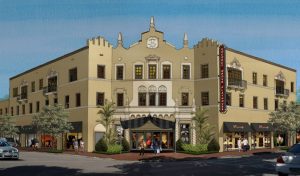 demolish the 1,100-seat theater and replace it with mixed-use development: A 300-seat theater, a 200-seat restaurant, some retail, possibly apartments and a 400-plus space parking garage. The only thing that will be restored is the entrance facade and box office. How is that a restoration? What historic restaurant was there?
demolish the 1,100-seat theater and replace it with mixed-use development: A 300-seat theater, a 200-seat restaurant, some retail, possibly apartments and a 400-plus space parking garage. The only thing that will be restored is the entrance facade and box office. How is that a restoration? What historic restaurant was there?
It’s a slap in the face to true preservationists and theater lovers — as well as voters.
“Its absurd for them to demolish the Playhouse,” said Carmen Pelaez, a playwright whose play RUM & COKE had an extended sold out run in the BlackBox at Coconut Grove Playhouse in 2003.
“Its history didn’t happen in the facade, it happened on both its stages. It’s one of of the the only historic theaters in Miami of national importance and it’s earned its right to be restored to its original MainStage and BlackBox configuration,” Pelaez said.
“Our goal should be to restore it’s reputation as a first class regional theater where pre-Broadway runs can develop next door to smaller curated productions giving local theater makers the chance to interact with their international peers and Miami theater goers can benefit from a thriving theatrical community in the heart of Miami.”
That sounds about right. In fact, it sounds a lot like what voters had in mind when they approved the $15 million the county wants to use (in total $20 M) on this project. The funds come from the 2004 Building Better Com munities Bond, where voters approved $15M of the pie for “reconstruction of Coconut Grove Playhouse to restore its structureal integrity and add to its performance and educational capabilities.” The other $5 mil come from the 2005 Convention Development Tax Bond for “the reconstruction and expansion to the Coconut Grove Playhouse to remedy structural deficiencies and improve the programmatic capabilities of the theater.”
munities Bond, where voters approved $15M of the pie for “reconstruction of Coconut Grove Playhouse to restore its structureal integrity and add to its performance and educational capabilities.” The other $5 mil come from the 2005 Convention Development Tax Bond for “the reconstruction and expansion to the Coconut Grove Playhouse to remedy structural deficiencies and improve the programmatic capabilities of the theater.”
Notice that nowhere does it say restaurant. Or apartments. Or Coach store. Notice the bonds were to expand the theater, not shrink it to less than a third of its size.
In 2004, two years before the doors closed because they couldn’t sell enough tickets, the Coconut Grove Playhouse had an economic impact estimated at more than $20 million per year and a report said it was responsible for up to 40% of the commercial activity in the area. Forty percent! That information, plus the promise to match the public funds through private fundraising, is what drove voters to approve a $15 million bond grant, again, to “restore [the] structural integrity and add to performance and educational capabilities.”
Now, 13 years later, the county is instead pursuing a plan that would invest that $15 million, plus another $5 mil, in  the building of a brand new 300-seat theater behind the historic theater’s entrance facade and turning it over, free-of-charge, to an organization with an average annual operating budget of $1.3 million, including public money that is not guaranteed forever. Ladra was informed that the county ignored its own criteria of requiring the “major cultural instutition” it provides the lease to have a $1.5 annual million budget. But the only year that Gables Stage had that, activists say, is in 2013, when it got an $800,000 grant from Miami-Dade itself.
the building of a brand new 300-seat theater behind the historic theater’s entrance facade and turning it over, free-of-charge, to an organization with an average annual operating budget of $1.3 million, including public money that is not guaranteed forever. Ladra was informed that the county ignored its own criteria of requiring the “major cultural instutition” it provides the lease to have a $1.5 annual million budget. But the only year that Gables Stage had that, activists say, is in 2013, when it got an $800,000 grant from Miami-Dade itself.
Then Ladra also hears that there wasn’t really an open, competitive process for the 99-year lease with Gables Stage and the Florida International University. These two are fine institutions and wonderful providers of theater, and as the mother of a 16-year-old thespian and musical theater enthusiast with very few options out there, I’m excited about the educational opportunities (hoping they are affordable). But was the process fair? And couldn’t a more collaborative effort by many other theater companies be better? Some in the theater industry feel like it was a cooked deal that “wreaks of favoritism.”
And then there is the undeniable feeling — supported by recent multi-million property sales — that this is being railroaded through as part of a bigger picture redevelopment of the old Grove main street business district. In other words, this may be driven by money, not art. Activists and Playhouse lovers feel blindsided. They say that Miami Dade Cultural Affairs Director Michael Springer had promised not to demolish the theater in 2013. But now, they say, they feel like this has always been the plan.
In 2013, another architect — a man who has restored Miami Freedom Tower, Miami City Hall, Miami Woman’s Club, Gusman Center for the Performing Arts and Vizcaya Village — had presented a plan to open a 700-seat theater and restore some of the interior of the Playhouse. Richard J. Heisenbottle wrote a letter recently published in the Coconut Grove Grapevine that also ought to be considered before the current plan moves forward:
“From the outset of discussion on the re-birth of the abandoned Coconut Grove Playhouse it has been assumed by the Miami-Dade County that only the front façade of the building is contributing to its historic designation. This assumption was made because the authors of the approved City of Miami Historic Designation Report, placed one sentence to that effect in the designation report. This one sentence probably went unnoticed by many HP Board members as they voted for its designation, but years later that one flawed sentence has shaped the assumptions on which Miami-Dade County’s cultural facilities building program was based. That assumption is that except for the main façade Miami-Dade County can tear down the remainder of the Richard Kiehnel designed theater and build a new 300 seat theater in its place.
“It is questionable whether those who authored this report ever toured the theater’s interior. For if they had, they would not have missed the remarkable original proscenium arch, low relief plaster ceiling, cornice moldings and twisted columns all of which are still intact and contribute to its historic character and its historic designation.
“This flawed assumption has resulted in the county commission voting to go forward with cultural facilities building program for a new 300-seat theater that is seriously flawed from cultural, economic and historic preservation perspectives. There are literally thousands of successful restored historic theaters throughout the country from Broadway to Main Street and the Coconut Grove Playhouse deserves to be one of them.”
There are a lot of people who feel a 700-seat theater would do more for the Grove than another restaurant. It would bring more people into the area that would then eat before or after a show. It would bring 700 people extra in, not 300 people and then a few hundred who were coming into the area anyway but now choose a new eatery to spend money in.
“At Washington University School of Business one of the first things we learned was that a business must define itself, what it is and what it does,” said activist Barry White. “The Coconut Grove Playhouse was and always should be a theater, a cultural and educational icon, and an economic driver for the area. In those roles it does not need to compete with restaurants and retail in the area for whom it is only supposed to attract visitors.
Some people would like to see two theaters remain.
“A 300-seat theater with 200 performances a year will attact 60,000 people annually and, at an average $35 per seat, produce $2.1 million in revenue. Adding a 750 seat theater with 200 performances a year would add 150,000 visitors per year and, at $35 per seat, add $5.2 mil a year. That is a total of $7.35 million in theater revenue and an additional 210,000 visitors to the Grove annually,” White said in an email to me where he directs himself to the historic preservation board.
“The Playhouse is a theater and an audience attractor. Don’t let misguided people who wrongly think it should be a self contained money machine disuade you. It will be a money machine by selling tickets to fine theatrical presentations to over 200,000 people annually — its only function, its only role.”
Activists also feel that Mike Eidson and The Coconut Grove Playhouse Foundation have caved in to the county’s pressure to demolish the historic theater, which, again, violates the voters’ mandate to use our tax monies to restore, not demolish, this landmark.
Miami-Dade Commissioner Xavier Suarez, who seems to be in favor of the current  plan but did not return a text late Monday from Ladra, has always been one to listen to his constituency and change course if he needs to. I hope he will put the brakes on this project until we can learn more about the possibility of a full restoration.
plan but did not return a text late Monday from Ladra, has always been one to listen to his constituency and change course if he needs to. I hope he will put the brakes on this project until we can learn more about the possibility of a full restoration.
There is concern that the decision Tuesday is already made, that money is talking here and that the hearing is just a show before the rubber stamp. Hopefully, there will be enough opponents to cause some pause of the demolition of this historic place. Because once the wrecking ball has gone through it, it will be too late.
Like Lt. Gov. Carlos Lopez-Cantera told everyone at the December 8 town hall meeting about the playhouse future: “This theater belongs to the people and the people decide what happens to it.”
And by “people,” Ladra is pretty sure he meant us, not those who stand to profit from building apartments.
read more
A group of West Kendall residents in a longtime fight against the redevelopment of the  Calusa Golf Course won an important battle last week when the Miami-Dade Commission basically did nothing — and, effectively, killed a proposal to turn the 168 acres into more homes.
Calusa Golf Course won an important battle last week when the Miami-Dade Commission basically did nothing — and, effectively, killed a proposal to turn the 168 acres into more homes.
But Ladra has a feeling that the war is not over and the plan could come back from the dead.
And the whole ordeal has left us with little trust in a government land use and zoning mechanism called a covenant.
Developers want to turn the abandoned golf course in the Calusa community into 670 homes buffered by 100 feet of green space that also includes a bike and pedestrian path. They tried to buy the adjacent and opposing residents — and commission votes to transmit the request for a land use change to Tallahassee — with the promise of potential picnic pavillions, zen gardens, play lots and a dog park on the 3.5 mile perimeter loop.
But homeowners have consistently said they don’t want any of that. And they point to a 99-year covenant with 49 more years on it and say they bought their homes based on this promise that the county made that the golf course would remain a golf course unless 75 percent of the adjacent and affected homeowners agreed with a new plan.
That’s not close to happening and Commissioner Audrey Edmonson suggested it would not ever happen — but she  doesn’t know that. Commissioner Sally Heyman said their attitude is “We want a golf course and nothing else.” But they haven’t said that. Both of them called the development urban infill. In West Kendall. Really.
doesn’t know that. Commissioner Sally Heyman said their attitude is “We want a golf course and nothing else.” But they haven’t said that. Both of them called the development urban infill. In West Kendall. Really.
The residents are opposed to wt developers are presenting now because they don’t like the density, which could add between 1,000 and 1,500 cars to their roads daily. Ladra is certain they like the dog park and the other shiny bells and whistles. Who wouldn’t? There could be room for negotiating if they go down in density. They say they’ve already come down from 1,100 units — 481 single-family houses and 619 town homes — which has to have been a bait and switch because nobody can legitimately conceive of that many units there. The comparible properties are between 2.5 and .64 dwellings per acre, so that would mean a maximum of 210 dwellings, though residents probably want to see it closer to around 54.
So, maybe something in the middle? How about 100? Developers still stand to make a ton of money.
And add a clubhouse with an indoor gym and basketball court. Or a public pool. Make it a deal the adjacent residents can’t refuse.
That’s what Commissioner Xavier Suarez, Ladra is certain, had in mind when he first sugges ted delaying the vote on the application until May so that, perhaps, the developers and the residents could come to some kind of an agreement. But he got pushback on that from commissioners who preferred to transmit the application, which sends the proposed redevelopment to state agencies for whatever input they would have — which, in this case, seems minimal and inconsecuential.
ted delaying the vote on the application until May so that, perhaps, the developers and the residents could come to some kind of an agreement. But he got pushback on that from commissioners who preferred to transmit the application, which sends the proposed redevelopment to state agencies for whatever input they would have — which, in this case, seems minimal and inconsecuential.
Both Commissioners Bruno Barreiro and Jose “Pepe” Diaz kept insisting that they were only seeking more information, though Ladra is uncertain what kind of information any state agency could provide on the impact of the redevelopment of this golf course. At least, what kind of information that would be more important than the facts at hand. Namely, the covenant that homeowner after homeowner referred to as part of their property rights.
The whole time this golf course has been discussed, the conversation centers on the 99-year covenant? If you look up the word covenant in the dictionary, some of its synonyms, you will find, are contract, agreement, commitment, guarantee, pledge, promise, bond.
How can commissioners continue to talk about covenants on other projects when they come back and pretend that this one doesn’t exist? Commissioner Rebeca Sosa had some difficulty with an action that should have given each and every one of them great pause.
“Who’s going to trust us,” Sosa asked.
Exactly.
It forced Suarez to make a motion to deny the transmittal, which died in a tie vote and was not resurrected before the meeting ended, so it, in effect, goes back to square one.
Suarez said that out of 484 letters or emails he got about the controversial plan, 480 mention the covenant. So it’s ont like this obscure, real estate term that none of the homeowners really knew what it meant. Just getting 484 letters or emails against a project is enough of a message to tell commissioners what they should do, even without a covenant. Dozens of them have attended at least three public hearings to urge our county government to deny the request.
But it’s going to come back. Golf courses have become the next horizon for developers who snatch them up, have them rezoned and then build whatever they want on what was once a grassy view.
Nobody is saying that this has to remain a golf course, if that is truly no longer a feasable use. But if this comes back without the resident’s approval, how can we ever believe that a covenant on any development — including, for example, the American Dream megamall — will be worth anything at all if this one is broken?
We can’t. Any break of a covenant will further erode what little trust we have left in local government.
read more
UPDATE: After the posting of this Thursday morning, the commission chairman called for a special meeting on Feb. 17. How they are going to get through the Feb. 7 meeting without talking about this is still a mystery.
There’s no question that Miami-Dade Commissioners will discuss the mayor’s directive last week to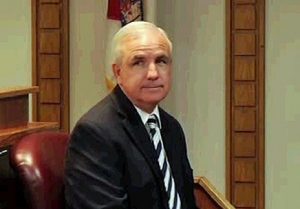 honor detention requests for illegal immigrants in county jails. The only question is when.
honor detention requests for illegal immigrants in county jails. The only question is when.
It may not be on Tuesday’s agenda — yet. But it can’t be ignored.
Not just because more than 300 county residents protested the decision Tuesday at County Hall. Not just because more than a dozen community groups and leaders have denounced the move. Not just because Commissioner Daniella Levine Cava asked Mayor Carlos Gimenez Monday to answer a series of questions about the impact and consequences of this cave-in to a legally questionable federal threat to withhold millions in funding. Not just becasue she wants her colleagues to join other U.S. cities challenging the legality of the president’s executive order.
Read related story: Carlos Gimenez betrays the community for Donald Trump
No. They have to talk about this because the mayor’s directive flies in the face of a 2013 resolution in which commissioners instructed him to do just the opposite. There is already a growing discontent among commissioners about what happened and how it happened. Some don’t want to send the message that the strong mayor can do whatever he wants for the next four years.
They can do several things. They can propose a resolution to just undo or rescind the resolution from 2013, which 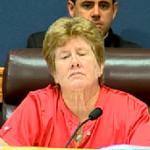 would be a show of support for the mayor’s actions and is rumored to be what Commissioner Sally Heyman has in mind. They can also direct the county attorney’s office to challenge the federal order, which is how Levine Cava leans. Neither one had presented a discussion item or legislation for Tuesday’s meeting, but either could. Gimenez could also put it on as a discussion item from the mayor’s office.
would be a show of support for the mayor’s actions and is rumored to be what Commissioner Sally Heyman has in mind. They can also direct the county attorney’s office to challenge the federal order, which is how Levine Cava leans. Neither one had presented a discussion item or legislation for Tuesday’s meeting, but either could. Gimenez could also put it on as a discussion item from the mayor’s office.
What won’t happen, one commission aide said, is nothing. “Otherwise, that’s going to be the biggest elephant in the chambers on Tuesday.”
Commissioner Xavier Suarez said he did not think that that Gimenez intended to violate the resolution but that he, at least, had some questions about the details. “I think it’s time for a clarification, whether it comes from the mayor’s office or it comes from us,” X told Ladra Wednesday.
The mayor’s memo to Corrections and Rehabilitation Director Daniel Junior, even though it’s only three paragraphs long, indicates that even Gimenez knew he’d have to get some kind of commission approval (note the last sentence).
“Yesterday, January 25, 2017, President Donald J. Trump issued Executive Order Enhancing Public Safety in the Interior of the United States.
In light of the provisions of the Executive Order, I direct you and your staff to honor all immigration detainer requests receive from the Department of Homeland Security.
Miami-Dade County complies with federal law and intends to fully cooperate with the federal government. I will partner with the Board of County Commissioners to address any issues necessary to achieve this end.”
Partner with the Board of County Commissioners, indeed. Some commissioners, staffers and other County Hall insiders say he should have waited and partnered with commissioners to address the issue before jumping to 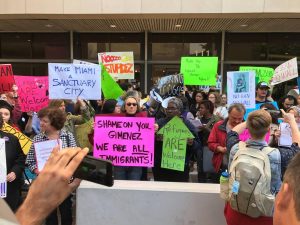 Trump’s drumbeat within 24 hours, becoming the first and so far only mayor of a major U.S. city to buckle.
Trump’s drumbeat within 24 hours, becoming the first and so far only mayor of a major U.S. city to buckle.
Que verguenza.
But beyond that, some go so far as to say the mayor may have abused his power by acting alone without calling for the rescinding of the resolution by the whole commission. It’s not like he didn’t have time.
Gimenez might say, whenever he is called upon to answer to commissioners, that he used his power as mayor to make this “emergency” decision. But there is no evidence that there was an emergency here. There was no deadline. Other cities have challenged the federal government’s authority to withhold funds while legal experts point to supreme court precedents that give states and municipalities the upper hand and also limit the conditions the government to withhold funds. There is no logical reason that Gimenez could not have waited to make it a mayor’s item on the Feb. 7 meeting.
Read related story: Levine Cava questions Gimenez on sanctuary about-face
Our own county attorney’s office told commissioners in 2013 that the county was complying with the Secure Communities requirements by sharing information — addresses, phone numbers, photographs — with ICE and the 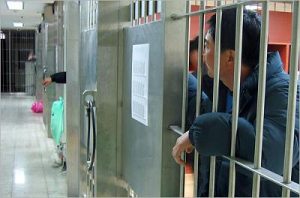 Department of Homeland Security. We have never stopped doing that since 2009.
Department of Homeland Security. We have never stopped doing that since 2009.
In 2013, commissioners adopted a new policy to release non-violent offenders who were also illegal immigrants unless the federal government covered the costs of prolongued incarceration and instructed the mayor to implement the policy. They did so mostly to save money. It was budget crunch time and they were told to look for extra funds to keep some of the programs that Gimenez wanted to cut in a drastic year after his 2012 re-election.
In a story published that year by the Miami Herald, Heyman said it wasn’t a purely financial decision.
“Not only is it about saving money. It’s about saving people,” she was quoted as saying.
What a difference three years makes, huh?
Of coure, the 2013 resolution that halted the detentions is all about the costs. It states that 3,262 detainer requests were honored in 2011 and 2,499 were honored in 2012, at a cost of a little over $1 million and $667,000, respectively. Of those, 57% were inmates not charged with felonies in 2011 and 61% were in 2012. These are people that were held for 48 hours after they were bonded out or released at arraignment.
They also had the green light from then County Attorney Roger Cuevas, who had told them in July that “compliance with ICE detainer requests is voluntary and not mandated by federal law or regulations.” Basically, the detainers or 48-hour “hold requests” are just that, requests. Cuevas’ analysis included wording from federal law and forms that showed the word “request” used repeatedly. He told commissioners that if they decided to hold detainees  for the 48 hours, there was no legal obligation for the federal government to reimburse costs.
for the 48 hours, there was no legal obligation for the federal government to reimburse costs.
Cuevas also attached a letter from ICE Assistant Director David Venturella in which he answers this direct question: “Is it ICE’s position that localities are required to hold individuals pursuant to Form I-247 or are detainers merely requests with which a county could legally decline to comply?” The response: “ICE views the immigration detainer as a request that a law enforcement agency maintain custody of an alien who may otherwise be released for up to 48 hours (excluding Saturdays, Sundays and holidays). This provides ICE time to assume custody of the alien.”
All of this can be found in the minutes of the December 3, 2013 meeting.
But the new policy did still provide for the detention of illegal immigrants when they had been either previously convicted of a forcible felony or charged with a non-bondable offense, such as murder. This is according to a memo from former Corrections and Rehabilitation Department Director Timothy Ryan to the Department of Homeland Security. So, we were still turning over the most violent offenders. Now, we’re just turning over the minor offenders, too, perhaps even people who are arrested for traffic violations.
Read related story: Protesters have demands of Carlos Gimenez on sanctuary
And everyone expects the Trump administration’s detainer requests to increase so we may soon be turning over even more of them.
There’s really only one reason why Gimenez would have jumped the gun and reached over the commission’s head to 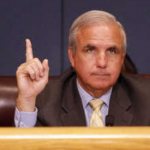 do something that law enforcement experts say damages community policing at a time when police resources are low and street shootings are at a high. It is to please the president so that his son, CJ Gimenez, could get more and friendlier access for his new federal lobbying gig. Ladra can’t think of any other reason why he would reverse a county commission policy within 24 hours with a directive that is going to become his legacy — the first thing that comes up on him now for all history in every story and Wikipedia: “Carlos Gimenez, the immigrant South Florida elected who was the first and only mayor who acquiesced to Donald Trump’s threats against sanctuary cities…”
do something that law enforcement experts say damages community policing at a time when police resources are low and street shootings are at a high. It is to please the president so that his son, CJ Gimenez, could get more and friendlier access for his new federal lobbying gig. Ladra can’t think of any other reason why he would reverse a county commission policy within 24 hours with a directive that is going to become his legacy — the first thing that comes up on him now for all history in every story and Wikipedia: “Carlos Gimenez, the immigrant South Florida elected who was the first and only mayor who acquiesced to Donald Trump’s threats against sanctuary cities…”
But he will soon have to explain for himself. Activists who have led a wave of public outcry that has resulted in two protests so far and whispers of a possible recall, promise to attend Tuesday’s meeting to demand answers.
So if commissioners don’t address the elephant in the room, the public will.
read more
Miami-Dade Mayor Carlos Gimenez was elected the commission chairman Tuesday.
Sure, the board chose Commissioner Esteban Bovo, Jr. over Xavier Suarez. But the victory 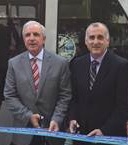 belongs to the mayor, who now has a compliant chairman and control of the commission agenda. You could see the satisfaction on his face when the two embraced after the vote. Watch for a bunch of “emergency” contracts to be awarded to companies you will find on Gimenez’s multiple campaign finance reports. You may also see the words “piggy back” and “waive” more often when it comes to the bidding process.
belongs to the mayor, who now has a compliant chairman and control of the commission agenda. You could see the satisfaction on his face when the two embraced after the vote. Watch for a bunch of “emergency” contracts to be awarded to companies you will find on Gimenez’s multiple campaign finance reports. You may also see the words “piggy back” and “waive” more often when it comes to the bidding process.
Gimenez campaigned hard for Bovo because he knows that he’s got him in his pocket. The two have been in cahoots since they committed absentee ballot fraud together in 2012. Bovo even used his district office in Hialeah as a drop-off point for boleteras. So ushering contracts and ordinances and resolultions through the commission, bypassing committees and the normal vetting process, is no big deal.
With a blow to checks and balances in one of the most important decisions the board can make — this can set the tone for the next two years — the vote was 8-5, with former 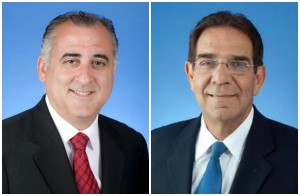 Chairman Jean Monestime and Commissioners Audrey Edmonson, Sally Heyman, Bruno Barreiro, Rebeca Sosa (who nominated him), Dennis Moss and Javier Souto joining Bovo’s nod for himself. Suarez was joined by Barbara Jordan (who nominated him), Daniella Levine Cava, Joe Martinez, and Jose “Pepe” Diaz.
Chairman Jean Monestime and Commissioners Audrey Edmonson, Sally Heyman, Bruno Barreiro, Rebeca Sosa (who nominated him), Dennis Moss and Javier Souto joining Bovo’s nod for himself. Suarez was joined by Barbara Jordan (who nominated him), Daniella Levine Cava, Joe Martinez, and Jose “Pepe” Diaz.
Ladra was surprised by Diaz, Monestime, Moss and Edmonson — until Edmonson got the vice chairmanship out of the blue. Was that a deal struck with Bovo for her vote? Shouldn’t have Suarez been made the vice chair?
Maybe too much damage was done already.
Ladra has said it before: X is his own worst enemy. His opening statements began with praise for Bovo, calling him a realist and applauding the way he has chaired the transportation committee. “I cannot imagine that I would outperform him. He has done eminently well. And he has a great sense of humor that I try to emulate,” Suarez said in what sounded way more like a Bovo endorsement than an opening pitch for himself.
Then he reminded them of his involvement in both the Frost Museum and the Liberty Square redevelopment — neither which has been smooth going. And then he rambled on and on about projects he has collaborated on with each of the commissioners, wasting time on people like Sosa and Souto who were not persuadable.
“I think I’ve broken the record in terms of Sunshine meetings and met with each of you in many times and worked out deals and agreements in a consentual way, supporting projects and actions,” he said. “I’m even ready to embrace water taxis if that works.”
Yeah, yeah, we get it. You are very collegial. And maybe too genuine. Which makes you a nice guy and a good public servant, but leaves you at a disadvantage as a politician.
Of course, he also quoted one or two intellectuals. But it seemed like a parade of minutia, and it didn’t really move the ball forward. Bovo talked about the future much more forcefully and persuasively and positioned himself as someone with a sense of urgency. “We, as a board now, enter a new dynamic — the dynamic of term limits,” Bovo said, referring to the term limits that were approved by voters in 2012 and are finally going to start kicking in. Six commissioners are running for their final time in 2018 and termed out in 2022. (Monestime, Heyman, Levine Cava, Sosa, Souto and Diaz). The ones re-elected this year, save Martinez, will be termed out in 2020 (Jordan, Edmonson, Barreiro, Suarez, Moss and Bovo).
While Suarez promised to inspire them, Bovo promised them a legacy.
“The time of procrastination, the time of long deliberations 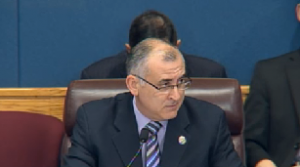 when at the end of the day studies would end up on the shelves, I believe are no longer present. I would like to see the county move progressively foward over the next two or four years,” he said, and those commissioners probably heard angels singing.
when at the end of the day studies would end up on the shelves, I believe are no longer present. I would like to see the county move progressively foward over the next two or four years,” he said, and those commissioners probably heard angels singing.
Transportation is going to be a priority, Bovo announced, like it wouldn’t be for anybody. And he mentioned a proposed “policy council that works hand in hand with administration to move policy forward… whether it’s funding for transportation or how do we address our prison.”
Notice he said administration instead of commission.
That’s why we still need Suarez to be the chairman for the community. Let Bovo represent the mayor, er, I mean the commission. X can assume a much more important role, which is to represent us and be the reality check for Mr. Puppet Chair.
It may be the only shred of checks and balances we have left.
read more
County Hall is abuzz with speculation about who will become the chair of the Miami-Dade Commission for the next two years. But the only thing that is certain right now is that it won’t be unanimous, like it was in 2014 when the commission showed a unified body behind today’s Chairman Jean Monestime.
next two years. But the only thing that is certain right now is that it won’t be unanimous, like it was in 2014 when the commission showed a unified body behind today’s Chairman Jean Monestime.
In a very important decision that could set the tone for the next two years, commissioners will elect the chair and vice chair on Tuesday. But while the two frontrunners couldn’t be any more different, both Xavier Suarez and the current vice chair Esteban Bovo Jr., were elected in the 2011 after-the-recall races and both are possible candidates for county mayor in 2020.
And, yes, it is a heated election for the chairmanship. Just because you can’t see all the behind-the-scenes campaigning, doesn’t mean it isn’t there.
Bovo and/or his people are telling everyone that he has the seven votes he needs. In fact, Back to the Future Commissioner Joe Martinez — whose people reportedly reached out for the public safety committee chairmanship — was told that Bovo doesn’t need his vote and that Sally Heyman had already been promised that committee.
In addition to Commissioner Heyman, apparently in a trade for the public safety committee, Bovo can probably count on his own vote and the votes of:
- Former chair Rebeca Sosa — because Bovo’s wife works for Sen. Marco Rubio, who is Sosa’s unofficial adopted son. She has been actively campaiging for Stevie.
- Javier Souto — because Esteban Bovo Sr. is a Brigade 2506 veteran and Bovo sponsored the ordinance that would ban the county from doing business with companies that did business in Cuba.
- Jose “Pepe” Diaz — because he is the mayor’s yes man and the mayor wants Bovo.
That’s five and he needs two more. Apparently, the rumor — that his camp has intentionally spread — is that he has the votes from Commissioner Audrey Edmonson and the current chair, Monestime.
But Ladra thinks Bovo is taking Edmonson for granted. Because, like, why? More likely, he may have the support of Commissioner Bruno Barreiro, because both of them served in the Florida House of Representatives even though at separate times. But that still makes only six. Because Monestime seems more ideologically and philosophically aligned with Suarez, who chairs his precious prosperity committee.
In addition to Monestime’s and his own vote, Ladra  strongly believes Suarez will get support from Martinez and Commissioners Barbara Jordan, Daniella Levine Cava and Dennis Moss, just because they seem to be on the same side of most commission votes. He only needs one more. Will it be Edmonson or Barreiro?
strongly believes Suarez will get support from Martinez and Commissioners Barbara Jordan, Daniella Levine Cava and Dennis Moss, just because they seem to be on the same side of most commission votes. He only needs one more. Will it be Edmonson or Barreiro?
Those two are arguably the only potential undecideds. And that is precisely why Bovo is spreading unsubstantiated and premature rumors about his alleged seven votes in the bag — to sway the undecideds. Or the soft leaning votes even. Because everyone wants to be with the winner.
Suarez has long indicated he wanted this position and has been campaigning longer. Some County Hall insiders think that he withdrew from this year’s mayoral race so that Mayor Carlos Gimenez would back him. Ladra believed them, especially when X seemed to ease off the pressure he had put on the mayor during previous years.
But no. Apparently, he was (1) refocusing his efforts to the chairmanship and (2) just being his collegial self.
It makes much more sense that Gimenez would campaign for Bovo because the compliant commissioner, who  campaigned and raised money for the mayor’s re-election bid, would be a puppet for him ready with a rubber stamp to make the Gimenez agenda a reality. Bovo has already come out very supportive of the American Dream mega mall that many of his constituents in Palm Springs North and Miami Lakes do not want. In fact, the mayor and Bovo share many of the same, um, benefactors. The mayor can count on Bovo to move items to the agenda without going through the committee process and to get all kinds of contracts pushed through for his friends and family plan. We’ll see a new, sudden “backlog of contracts” that needs to bypass committee discussion and be pushed through.
campaigned and raised money for the mayor’s re-election bid, would be a puppet for him ready with a rubber stamp to make the Gimenez agenda a reality. Bovo has already come out very supportive of the American Dream mega mall that many of his constituents in Palm Springs North and Miami Lakes do not want. In fact, the mayor and Bovo share many of the same, um, benefactors. The mayor can count on Bovo to move items to the agenda without going through the committee process and to get all kinds of contracts pushed through for his friends and family plan. We’ll see a new, sudden “backlog of contracts” that needs to bypass committee discussion and be pushed through.
After all, Gimenez has about $8 million of I.O.U.s out that he needs to start making good on.
There are several reasons the commission should choose X Tuesday instead of Bovo.
Suarez is a brilliant and persuasive speaker with a track record of proven leadership not only in his district but countywide. He is a charming, disarming modern Renaissance Man with a knack for bringing people together who gets along with almost everybody, including people from both sides of the aisle. An independent or no party affiliation voter, he has supported both Democrats and Republicans in state elections and has close friends and advisors from both the blue and the red teams. And he believes that light rail, not bus rapid transit, is what must happen for South Dade and that all the corridor mass transit projects can be sought simultaneously and paid for without more taxes. He has helped identify funding and it looks like he has come up with more initiatives and plans to get projects off the ground than anyone.
Bovo, meanwhile, is a GOP loyalist with absolutely no friends on the other side and such an integral part of that  Hialeah absentee ballot machinery that his district office became a drop-off point for fraudulent votes in the 2012 election. He won his seat by stabbing his predecessor, former Commissioner Natacha Seijas, in the back, campaigning for her recall so he could take her place. Later, his chief of staff, who was moonlighting as a lobbyist, was busted in the same federal bribery case that took down former Sweetwater Mayor Manny Maroño. He has had some good days since, Ladra admits, but he is not known for building consensus, hires questionable staffers and is extremely disrespectful to the labor unions and employees, who generally dislike him. He supported Gimenez’s proposal to close libraries, saying they could be housed in park buildings. And he’s an early and consistent proponent of rapid bus rather than rail who also wants to pay for mass transit improvements with additional tax dollars by creating one or more special taxing districts in the areas it would serve.
Hialeah absentee ballot machinery that his district office became a drop-off point for fraudulent votes in the 2012 election. He won his seat by stabbing his predecessor, former Commissioner Natacha Seijas, in the back, campaigning for her recall so he could take her place. Later, his chief of staff, who was moonlighting as a lobbyist, was busted in the same federal bribery case that took down former Sweetwater Mayor Manny Maroño. He has had some good days since, Ladra admits, but he is not known for building consensus, hires questionable staffers and is extremely disrespectful to the labor unions and employees, who generally dislike him. He supported Gimenez’s proposal to close libraries, saying they could be housed in park buildings. And he’s an early and consistent proponent of rapid bus rather than rail who also wants to pay for mass transit improvements with additional tax dollars by creating one or more special taxing districts in the areas it would serve.
But the biggest reason why we should want X as chair instead of Stevie is because Suarez is a stickler for process with a higher regard for transparency who will hold the mayor’s feet to the fire and represent the commission on the dais and in his office, while Bovo is a Gimenez apologist and pocket commissioner who will be looking out for the 29th floor and let the mayor control the agenda.
You know what? It should be unanimous.
Call your commissioner (phone numbers are on this website) and tell them that you want Xavier Suarez to be the chair. This is even more important if you live in District 3 (Edmonson’s office number downtown is 305-375-5393) or District 5 (Barreiro’s office number is 305-643-8525). Hurry up. The meeting starts at 9:30 Tuesday.
read more
This is a new fe ature that debuts today on Political Cortadito.
ature that debuts today on Political Cortadito.
The Cortadito Calendar: A weekly calendar of political powwows, events with electeds and meaningful or not so meaningful meetings.
Now you know what’s going on. You have no excuses.
MONDAY — Dec. 5
7 p.m. — The New Administration and Prospects For Peace present New York Times columnist Roger Cohen and a discussion about what the elections results will mean for efforts to reach peace in the Middle East. Cohen, a staple at the NYT for 25 years is also the author of four books. The latest, published last year, is a family memoir entitled “The Girl from Human Street: Ghosts of Memory in a Jewish Family” that has received wide acclaim. The event begins at 7 p.m. in the Hibiscus Room at Pinecrest Gardens, 11000 Red Road.
TUESDAY — Dec. 6
9 a.m. — Miami-Dade Commissioner Joe Martinez is back Tuesday for his first county  commission meeting — in four years. Martinez was termed out in 2012 and ran for mayor against Carlos Gimenez, but lost. He then ran for Congress, but lost again. He only won in August because Commissioner Juan Zapata dropped out of the race. It should be interesting to watch how he is welcomed. Or not. Folks at County Hall tell me that there are some people who are bristling. Martinez is former cop with an anger management issue who can hold a grudge with the best of ’em and it is no secret he feels slighted by folks at the 111 building. But he is also smarter than he looks and experienced with the county budget and processes. It will be hard for “Cry Wolf” Gimenez to pull th wool over Joe’s eyes. But it could be fun to watch him try. Sit in the audience at commission chambers at County Hall, 111 NW 1st Street. Or watch live: Channel 76 on Comcast or on the county website.
commission meeting — in four years. Martinez was termed out in 2012 and ran for mayor against Carlos Gimenez, but lost. He then ran for Congress, but lost again. He only won in August because Commissioner Juan Zapata dropped out of the race. It should be interesting to watch how he is welcomed. Or not. Folks at County Hall tell me that there are some people who are bristling. Martinez is former cop with an anger management issue who can hold a grudge with the best of ’em and it is no secret he feels slighted by folks at the 111 building. But he is also smarter than he looks and experienced with the county budget and processes. It will be hard for “Cry Wolf” Gimenez to pull th wool over Joe’s eyes. But it could be fun to watch him try. Sit in the audience at commission chambers at County Hall, 111 NW 1st Street. Or watch live: Channel 76 on Comcast or on the county website.
7 p.m. — Newly elected Miami Lakes Mayor Manny Cid will have his first meeting as mayor,  having been sworn in last week after he beat former Mayor Michaeld “Muscles” Pizzi in a runoff, 77 to 23 percent. The meeting will also be graced by new council member Luis Collazo (it’s still an all boys club). And they have a pretty big agenda. They will review site plans for approval (inluding one for the Graham Companies), an amendment to their development code, several contracts with city vendors and the hiring of a lobbyist. They will talk about MDX, special taxing districts, modifying the budget (already?), requiring fences around construction areas, a toy drive and venomous snakes. Sounds like fun. The council chambers are at Town Hall, 6601 Main Street.
having been sworn in last week after he beat former Mayor Michaeld “Muscles” Pizzi in a runoff, 77 to 23 percent. The meeting will also be graced by new council member Luis Collazo (it’s still an all boys club). And they have a pretty big agenda. They will review site plans for approval (inluding one for the Graham Companies), an amendment to their development code, several contracts with city vendors and the hiring of a lobbyist. They will talk about MDX, special taxing districts, modifying the budget (already?), requiring fences around construction areas, a toy drive and venomous snakes. Sounds like fun. The council chambers are at Town Hall, 6601 Main Street.
WEDNESDAY — Dec. 7
9 a.m. — Pinecrest Council Workshop at the Pinecrest Municipal Center, 12645 Pinecrest Parkway, in council chambers.
THURSDAY — Dec. 8
6-8 p.m. — Miami-Dade County’s Department of Cultural Affairs will have a town hall  meeting to unveil preliminary site plans for the renovation of the Coconut Grove Playhouse and get community input. The plans to be presented have been developed by a design team led by Arquitectonica per their contract with Miami-Dade County and not the Coconut Grove Playhouse Foundation. The town hall begins at 6 p.m. at Ransom Everglades School, 3575 Main Highway. Expect Miami-Dade Commissioner Xavier Suarez, who has long championed the renovation of the cultural landmark, to be front and center and Miami Commissioner Ken Russell to attend.
meeting to unveil preliminary site plans for the renovation of the Coconut Grove Playhouse and get community input. The plans to be presented have been developed by a design team led by Arquitectonica per their contract with Miami-Dade County and not the Coconut Grove Playhouse Foundation. The town hall begins at 6 p.m. at Ransom Everglades School, 3575 Main Highway. Expect Miami-Dade Commissioner Xavier Suarez, who has long championed the renovation of the cultural landmark, to be front and center and Miami Commissioner Ken Russell to attend.
If you know of any political happening that should be included in the Cortadito Calendar, please email the information to edevalle@gmail.com and thank you.
read more
 meet Tuesday afternoon to consider an application to “restore” the Coconut Grove Playhouse, they ought to look up the word restore in the dictionary.
meet Tuesday afternoon to consider an application to “restore” the Coconut Grove Playhouse, they ought to look up the word restore in the dictionary. demolish the 1,100-seat theater and replace it with mixed-use development: A 300-seat theater, a 200-seat restaurant, some retail, possibly apartments and a 400-plus space parking garage. The only thing that will be restored is the entrance facade and box office. How is that a restoration? What historic restaurant was there?
demolish the 1,100-seat theater and replace it with mixed-use development: A 300-seat theater, a 200-seat restaurant, some retail, possibly apartments and a 400-plus space parking garage. The only thing that will be restored is the entrance facade and box office. How is that a restoration? What historic restaurant was there? munities Bond, where voters approved $15M of the pie for “reconstruction of Coconut Grove Playhouse to restore its structureal integrity and add to its performance and educational capabilities.” The other $5 mil come from the 2005 Convention Development Tax Bond for “the reconstruction and expansion to the Coconut Grove Playhouse to remedy structural deficiencies and improve the programmatic capabilities of the theater.”
munities Bond, where voters approved $15M of the pie for “reconstruction of Coconut Grove Playhouse to restore its structureal integrity and add to its performance and educational capabilities.” The other $5 mil come from the 2005 Convention Development Tax Bond for “the reconstruction and expansion to the Coconut Grove Playhouse to remedy structural deficiencies and improve the programmatic capabilities of the theater.” the building of a brand new 300-seat theater behind the historic theater’s entrance facade and turning it over, free-of-charge, to an organization with an average annual operating budget of $1.3 million, including public money that is not guaranteed forever. Ladra was informed that the county ignored its own criteria of requiring the “major cultural instutition” it provides the lease to have a $1.5 annual million budget. But the only year that Gables Stage had that, activists say, is in 2013, when it got an $800,000 grant from Miami-Dade itself.
the building of a brand new 300-seat theater behind the historic theater’s entrance facade and turning it over, free-of-charge, to an organization with an average annual operating budget of $1.3 million, including public money that is not guaranteed forever. Ladra was informed that the county ignored its own criteria of requiring the “major cultural instutition” it provides the lease to have a $1.5 annual million budget. But the only year that Gables Stage had that, activists say, is in 2013, when it got an $800,000 grant from Miami-Dade itself. plan but did not return a text late Monday from Ladra, has always been one to listen to his constituency and change course if he needs to. I hope he will put the brakes on this project until we can learn more about the possibility of a full restoration.
plan but did not return a text late Monday from Ladra, has always been one to listen to his constituency and change course if he needs to. I hope he will put the brakes on this project until we can learn more about the possibility of a full restoration.
 Calusa Golf Course
Calusa Golf Course

















